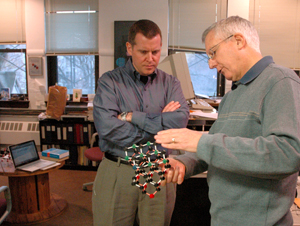Protein wrap
By Benjamin Recchie, AB'03
Photography by Jessi Scurti

Proteins are kind of blobby things,” says computer scientist L. Ridgway Scott. “They don’t look like they would interact in a discrete or digital way, but yet they do.” Scott (at right) and visiting biochemist Christopher Fraser, SM’08, have designed computer simulations that predict how proteins, based on their structures, interact with each other and with water. This digital biology, as Scott dubs it, isn’t a theoretical exercise: the human body is mostly proteins and water, and a better understanding of how the two interact would be a major advance in pharmacology.
Key to their efforts are the bonds that tie hydrogen to other atoms in the protein. Depending on the hydrogen’s orientation, it can repel water—a state Scott calls “wrapped”—or attract it, in which case it’s “unwrapped.” Because water tends to break down proteins, determining where the unwrapped hydrogen bonds, or dehydrons, are located allows them to predict how well proteins will bond with other proteins.
With researchers from Rice University and the École Polytechnique in France, Scott and Fraser are developing a program called WRAPPA (Web-based Residue Analysis Program for Phobicity Assessment), which biochemists and other life scientists can use to determine the dehydrons’ location on a protein. Fraser, who had earned a PhD in biochemistry at Purdue before coming to Chicago, describes the ultimate goal of the project, expected to be complete this spring: “If you take into consideration wrapping technology, you can redesign a drug” to be more effective and have fewer side effects.
Return to top
